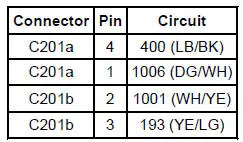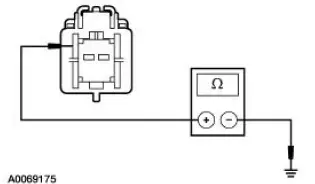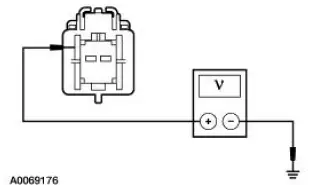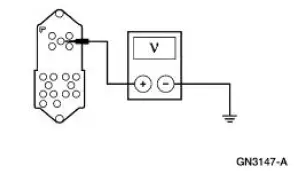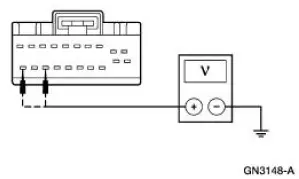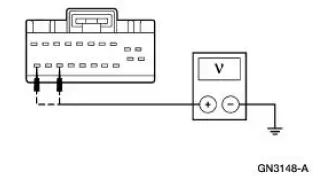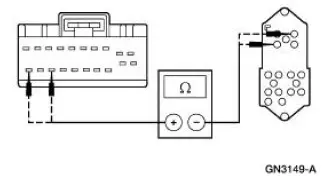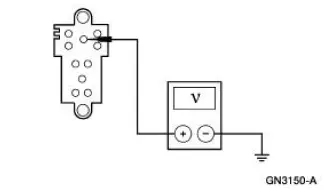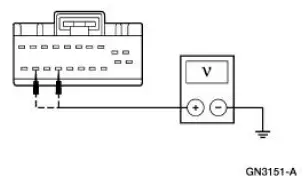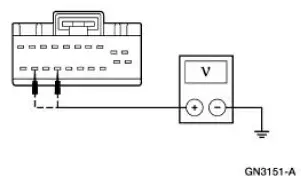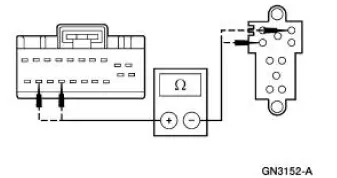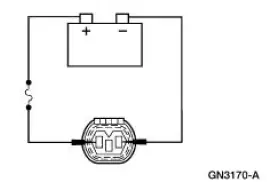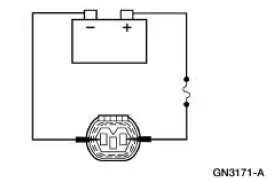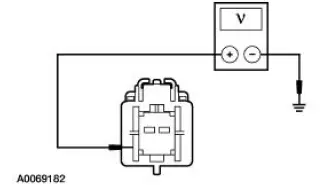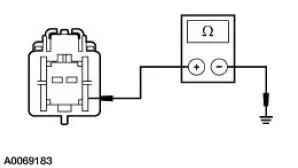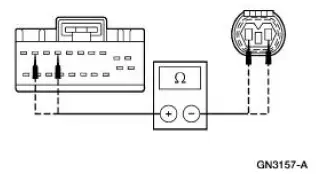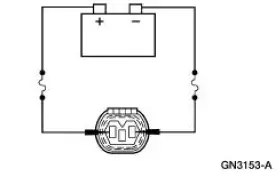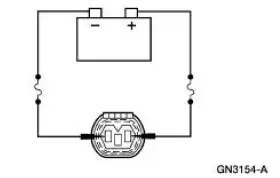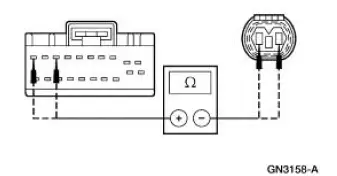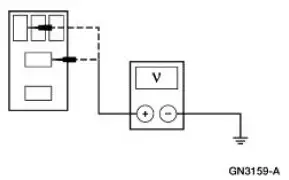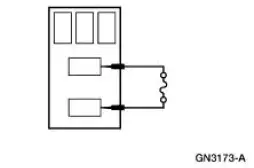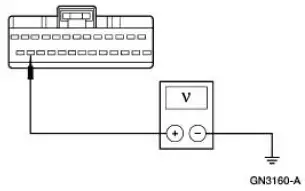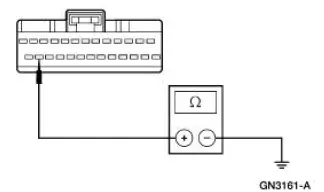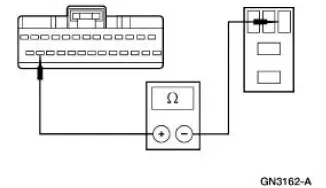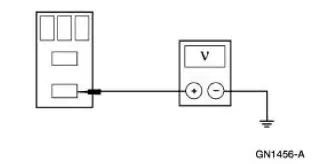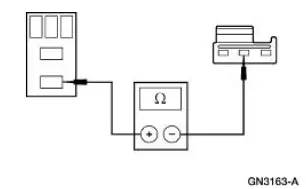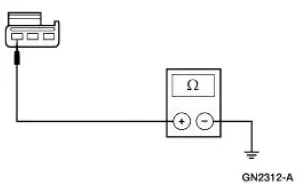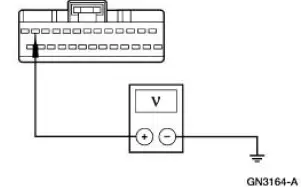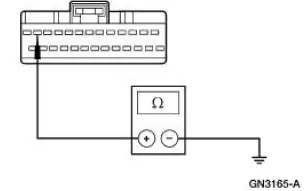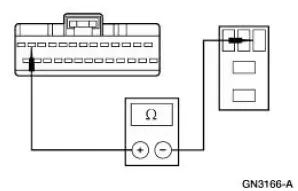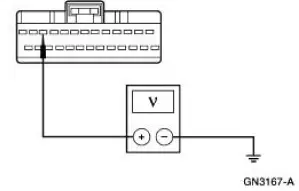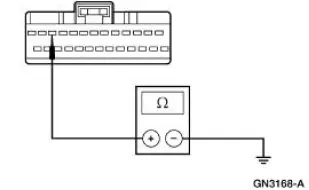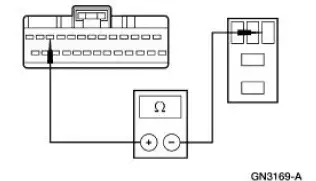Ford Mustang (1999-2004) Service Manual: Inspection and Verification
1. The keyless entry system is a generic electronic module (GEM).
2. Verify the customer concern by using the remote transmitters to operate the keyless entry system.
3. Visually inspect for the following obvious signs of mechanical and electrical damage.
Visual Inspection Chart
| Mechanical | Electrical |
|
|
4. If the concern remains after the inspection, connect the scan tool to the data link connector (DLC) located beneath the instrument panel and select the vehicle to be tested from the scan tool menu. If the scan tool does not communicate with the vehicle:
- check that the program card is correctly installed.
- check the connections to the vehicle.
- check the ignition switch position.
5. If the scan tool still does not communicate with the vehicle, refer to the scan tool manual.
6. Carry out the DATA LINK DIAGNOSTIC TEST. If the scan tool responds with:
- CKT914, CKT915 or CKT70 = ALL ECUS NO RESP/NOT EQUIP, refer to Section.
- NO RESP/NOT EQUIP for GEM, go to Pinpoint Test A.
- SYSTEM PASSED, retrieve and record the continuous diagnostic trouble codes (DTCs), erase the continuous DTCs, and carry out the self-test diagnostics for the GEM.
7. If the DTCs retrieved are related to the concern, go to the GEM Diagnostic Trouble Code (DTC) Index to continue diagnostics.
8. If no DTCs related to the concern are retrieved, proceed to Symptom Chart to continue diagnostics.
GEM Diagnostic Trouble Code (DTC) Index
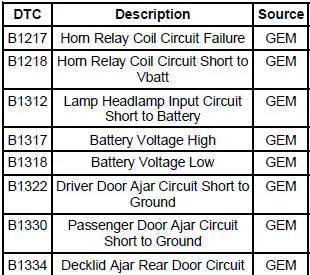

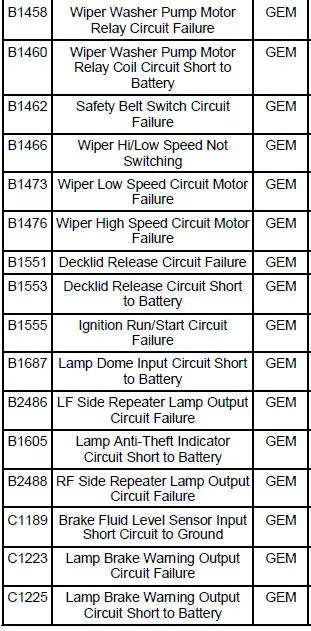
Symptom Chart
| Condition | Possible Sources | Action |
|
|
|
|
|
|
|
|
|
|
|
|
|
|
|
Pinpoint Tests
PINPOINT TEST A: NO COMMUNICATION WITH THE GENERIC ELECTRONIC MODULE
| Test Step | Result / Action to Take |
| CAUTION: Use the correct probe adapter(s) when making measurements. Failure to use the correct probe adapter(s) may damage the connector. | |
| A1 CHECK THE GENERIC ELECTRONIC MODULE (GEM) POWER SUPPLY | Yes GO to A2 . No REPAIR the circuit(s) in question. TEST the system for normal operation. |
|
|
| A2 CHECK THE GEM GROUND CIRCUIT 397 (BK/WH) FOR OPEN | Yes GO to A3 . No REPAIR the circuit(s) in question. TEST the system for normal operation |
|
|
| A3 CHECK CIRCUIT 397 (BK/WH) FOR SHORT TO POWER | Yes REPAIR the circuit. TEST the system for normal operation. No REFER to Section |
|
|
PINPOINT TEST B: ALL DOOR LOCKS ARE INOPERATIVE
| Test Step | Result / Action to Take |
| B1 CHECK POWER LOCK INPUTS TO THE GEM | Yes GO to B11 . No GO to B2 . |
|
|
| B2 ISOLATE BETWEEN THE DRIVER AND PASSENGER POWER DOOR LOCK SWITCHES | Yes GO to B7 . No GO to B3 . |
NOTE: This PID may not be supported in the normal scan tool PID list. It can be located in the Function test - "Transmitter Tic/Data".
|
|
| B3 CHECK CIRCUIT 326 (WH/VT) FOR VOLTAGE - DRIVER SIDE | Yes GO to B4 . No REPAIR Circuit 326 (WH/VT). REPEAT the self-test. CLEAR the DTCs. |
|
|
| B4 CHECK THE DRIVER POWER DOOR LOCK SWITCH FOR CORRECT OPERATION | Yes GO to B5 . No INSTALL a new master window/door lock control switch. REPEAT the selftest. CLEAR the DTCs. |
|
|
| B5 CHECK CIRCUITS 129 (LG) AND 1014 (VT) FOR SHORT TO POWER | Yes REPAIR the circuit in question. REPEAT the self-test. CLEAR the DTCs. No GO to B6 . |
|
|
| B6 CHECK CIRCUITS 129 (LG) AND 1014 (VT) FOR OPEN | Yes INSTALL a new GEM. For additional information, REFER to Section. REPEAT the selftest. CLEAR the DTCs. No REPAIR the circuit in question. REPEAT the self-test. CLEAR the DTCs. |
|
|
| B7 CHECK CIRCUIT 326 (WH/VT) FOR VOLTAGE - PASSENGER SIDE | Yes GO to B8 . No REPAIR Circuit 326 (WH/VT). REPEAT the self-test. CLEAR the DTCs. |
|
|
| B8 CHECK THE PASSENGER POWER DOOR LOCK SWITCH FOR CORRECT OPERATION | Yes GO to B9 . No INSTALL a new master window/door lock control switch. REPEAT the selftest. CLEAR the DTCs. |
|
|
| B9 CHECK CIRCUITS 119 (PK/YE) AND 120 (PK/LG) FOR SHORT TO POWER | Yes REPAIR the circuit in question. REPEAT the self-test. CLEAR the DTCs. No GO to B10 . |
|
|
| B10 CHECK CIRCUITS 119 (PK/YE) AND 120 (PK/LG) FOR OPEN | Yes INSTALL a new GEM. For additional information, REFER to Section. REPEAT the selftest. CLEAR the DTCs. No REPAIR the circuit in question. REPEAT the self-test. CLEAR the DTCs. |
|
|
| B11 CHECK GEM CONTROL OF THE POWER DOOR LOCKS | Yes INSTALL a new GEM. For additional information, REFER to Section. REPEAT the selftest. CLEAR the DTCs. No GO to B12 . |
|
|
| B12 ISOLATE BETWEEN DRIVER AND PASSENGER POWER LOCK ACTUATORS | Yes GO to B17 . No GO to B13 . |
|
|
| B13 CHECK THE DRIVER POWER LOCK ACTUATOR OPERATION | Yes GO to B14 . No INSTALL a new driver door lock actuator. For additional information, REFER to Actuator . REPEAT the selftest. CLEAR the DTCs. |
|
|
| B14 CHECK CIRCUIT 193 (YE/LG) FOR OPEN | Yes GO to B15 . No REPAIR Circuit 193 (YE/LG). REPEAT the self-test. CLEAR the DTCs. |
NOTE: Verify voltage at BJB Fuse POWER WINDOWS (40A) before completing this step.
|
|
| B15 CHECK CIRCUIT 1205 (BK) FOR OPEN | Yes GO to B16 . No REPAIR Circuit 1205 (BK). REPEAT the self-test. CLEAR the DTCs. |
|
|
| B16 CHECK CIRCUITS 163 (PK/YE) AND 1015 (RD/WH) FOR OPEN | Yes INSTALL a new GEM. For additional information, REFER to Section. REPEAT the selftest. CLEAR the DTCs. No REPAIR the circuit in question. REPEAT the self-test. CLEAR the DTCs. |
|
|
| B17 CHECK THE PASSENGER POWER LOCK ACTUATOR OPERATION | Yes GO to B18 . No INSTALL a new passenger door lock actuator. REFER to Actuator . REPEAT the self-test. CLEAR the DTCs. |
|
|
| B18 CHECK CIRCUITS 163 (RD/OG), 1015 (RD/WH), 117 (PK/BK), AND 118 (PK/OG) FOR OPEN | Yes INSTALL a new GEM. For additional information, REFER to Section. REPEAT the selftest. CLEAR the DTCs. No REPAIR the circuit in question. REPEAT the self-test. CLEAR the DTCs. |
|
PINPOINT TEST C: THE DOORS DO NOT LOCK/UNLOCK USING THE REMOTE TRANSMITTER
| Test Step | Result / Action to Take |
| C1 CHECK THE LOCK OPERATION USING THE DRIVER DOOR LOCK SWITCH | Yes GO to C2 . No GO to Pinpoint Test B . |
|
|
| C2 CHECK IGNITION STATES | Yes GO to C3 . No For key-in-ignition concerns, REFER to Section . |
|
|
| C3 CHECK THE GEM FUNCTION TEST TIC/DATA | Yes INSTALL a new GEM. For additional information, REFER to Section. REPEAT the self-test. CLEAR the DTCs. No GO to C4 . |
NOTE: This PID may not be supported in the normal scan tool PID list. It can be located in the Function Test - "Transmitter Tic/DATA". When this test is activated, the appropriate results may be obtained when pressing the keyfob buttons.
|
|
| C4 CHECK THE BATTERIES IN THE REMOTE TRANSMITTER | Yes SYSTEM is OK. REPEAT the self-test. CLEAR the DTCs. No GO to C5 . |
|
|
| C5 REPROGRAM THE REMOTE TRANSMITTERS TO THE GEM | Yes SYSTEM is OK. REPEAT the self-test. CLEAR the DTCs. No PROGRAM a new remote transmitter to the vehicle. For additional information, REFER to Programming-Keyless Entry Remote Transmitter . REPEAT the self-test. CLEAR the DTCs. If the problem still remains, INSTALL a new GEM and program the remote transmitters to the vehicle. For additional information, REFER to Section . REPEAT the self-test. CLEAR the DTCs. |
|
PINPOINT TEST D: THE LUGGAGE COMPARTMENT DOOR IS INOPERATIVE USING THE REMOTE TRANSMITTER
| Test Step | Result / Action to Take |
| D1 CHECK IGNITION STATES | Yes GO to D2 . No REFER to Section for key-in-ignition warning chime concerns |
|
|
| D2 CHECK THE GEM PID LAST DATA RECEIVED FOR LUGGAGE COMPARTMENT | Yes GO to D5 . No GO to D3 . |
|
|
| D3 CHECK THE BATTERIES IN THE REMOTE TRANSMITTER | Yes SYSTEM is OK. REPEAT the self-test. CLEAR the DTCs. No GO to D4 . |
|
|
| D4 REPROGRAM THE REMOTE TRANSMITTERS TO THE GEM | Yes SYSTEM is OK. REPEAT the self-test. CLEAR the DTCs. No PROGRAM a new remote transmitter to the vehicle. For additional information, REFER to Programming-Keyless Entry Remote Transmitter . REPEAT the self-test. CLEAR the DTCs. If the problem still remains, INSTALL a new GEM and program the remote transmitters to the vehicle. For additional information, REFER to Section. REPEAT the self-test. CLEAR the DTCs. |
|
|
| D5 CHECK THE GEM OUTPUT TO THE LUGGAGE COMPARTMENT | Yes INSTALL a new GEM. For additional information, REFER to Section. REPEAT the self-test. CLEAR the DTCs. No GO to D6 . |
|
|
| D6 CHECK CIRCUIT 931 (OG) FOR OPEN | Yes GO to D7 . No REPAIR Circuit 931 (OG). REPEAT the self-test. CLEAR the DTCs. |
|
|
| D7 BYPASS THE GEM AND RELAY CONTROL | Yes GO to D8 . No GO to D12 . |
|
|
| D8 CHECK LUGGAGE COMPARTMENT LID RELEASE RELAY | Yes GO to D9 . No INSTALL a new luggage compartment lid release relay. REPEAT the self-test. CLEAR the DTCs. |
|
|
| D9 CHECK CIRCUIT 599 (PK/LG) FOR SHORT TO POWER | Yes REPAIR Circuit 599 (PK/LG). REPEAT the self-test. CLEAR the DTCs. No GO to D10 |
|
|
| D10 CHECK CIRCUIT 599 (PK/LG) FOR SHORT TO GROUND | Yes GO to D11 . No REPAIR Circuit 599 (PK/LG). REPEAT the self-test. CLEAR the DTCs. |
|
|
| D11 CHECK CIRCUIT 599 (PK/LG) FOR OPEN | Yes INSTALL a new GEM. For additional information, REFER to Section. REPEAT the self-test. CLEAR the DTCs. No REPAIR Circuit 599 (PK/LG). REPEAT the self-test. CLEAR the DTCs. |
|
|
| D12 CHECK CIRCUIT 84 (VT/YE) FOR SHORT TO POWER | Yes REPAIR Circuit 84 (VT/YE). REPEAT the self-test. CLEAR the DTCs. No GO to D13 . |
|
|
| D13 CHECK CIRCUIT 84 (VT/YE) FOR OPEN | Yes GO to D14 . No REPAIR Circuit 84 (VT/YE). REPEAT the self-test. CLEAR the DTCs. |
|
|
| D14 CHECK CIRCUIT 1205 (BK) FOR OPEN | Yes INSTALL a new luggage compartment lid release switch. REPEAT the self-test. CLEAR the DTCs. No REPAIR Circuit 1205 (BK). REPEAT the self-test. CLEAR the DTCs. |
|
PINPOINT TEST E: PANIC FUNCTION DOES NOT OPERATE CORRECTLY
| Test Step | Result / Action to Take |
| E1 CHECK IGNITION STATES | Yes GO to E2 . No REFER to Section |
|
|
| E2 CHECK THE GEM PID LAST DATA RECEIVED FOR PANIC | Yes GO to E3 . No GO to Pinpoint Test D . |
|
|
| E3 CHECK THE COURTESY LAMPS | Yes GO to E4 . No REFER to Section |
|
|
| E4 CHECK THE GEM OUTPUT TO THE HORN | Yes GO to E5 . No GO to E6 |
|
|
| E5 CHECK THE GEM OUTPUT TO THE PARKING LAMPS | Yes INSTALL a new GEM. For additional information, REFER to Section. REPEAT the self-test. CLEAR the DTCs. No GO to E10 . |
|
|
| E6 CHECK CIRCUIT 6 (YE/LG) FOR SHORT TO POWER | Yes GO to E7 . No REPAIR Circuit 6 (YE/LG). REPEAT the self-test. CLEAR the DTCs. |
|
|
| E7 CHECK CIRCUIT 6 (YE/LG) FOR SHORT TO GROUND | Yes GO to E8 . No REPAIR Circuit 6 (YE/LG). REPEAT the self-test. CLEAR the DTCs. |
|
|
| E8 CHECK CIRCUIT 6 (YE/LG) FOR OPEN | Yes GO to E9 . No REPAIR Circuit 6 (YE/LG). REPEAT the self-test. CLEAR the DTCs. |
|
|
| E9 CHECK THE HORN FOR NORMAL OPERATION | Yes INSTALL a new GEM. For additional information, REFER to Section. REPEAT the self-test. CLEAR the DTCs. No REFER to Section |
|
|
| E10 CHECK CIRCUIT 1032 (WH/BK) FOR SHORT TO POWER | Yes GO to E11 . No REPAIR Circuit 1032 (WH/BK). REPEAT the self-test. CLEAR the DTCs. |
|
|
| E11 CHECK CIRCUIT 1032 (WH/BK) FOR SHORT TO GROUND | Yes GO to E12 . No REPAIR Circuit 1032 (WH/BK). REPEAT the self-test. CLEAR the DTCs. |
|
|
| E12 CHECK CIRCUIT 1032 (WH/BK) FOR OPEN | Yes GO to E13 No REPAIR Circuit 1032 (WH/BK). REPEAT the self-test. CLEAR the DTCs. |
|
|
| E13 CHECK THE PARKING LAMPS FOR NORMAL OPERATION | Yes INSTALL a new GEM. For additional information, REFER to Section. REPEAT the self-test. CLEAR the DTCs. No REFER to Section |
|
 Principles of Operation
Principles of Operation
NOTE: Battery power and ground must be remove before disconnecting
the GEM connectors to avoid
setting false codes.
Power Locks Operation
The power locks feature allows the customer to lock a ...
 Keyless Entry/Computer Operated Locks
Keyless Entry/Computer Operated Locks
Programming -Keyless Entry Remote Transmitter
NOTE: All keyless entry remote transmitters (15K601) must be
programmed at the same time.
NOTE: All previous transmitter identification codes (TIC ...
Other materials:
Condenser to Evaporator Line
Material
Item
Specification
PAG Refrigerant Compressor
Oil (R-134a Systems)
F7AZ-19589-DA (Motorcraft YN-
12-C)
WSH-M1C231-
B
Removal and Installation
NOTE: Installation of a new suction accumulator is not required when
repairing the ...
Torque Converter End Play Check
Special Tool(s)
Dial Indicator Gauge with
Holding Fixture
100-002 (TOOL-4201-C) or
equivalent
End Play Gauge, Torque
Converter
307-071 (T80L-7902-A) or
equivalent
1. Install the special tool into the torque converter pump ...
Transmission (Assembly)
Special Tool(s)
Dial Indicator Gauge with
Holding Fixture
100-002 (TOOL-4201-C) or
equivalent
Holding Fixture, Transmission
307-003 (T57L-500-B)
Remover/Installer, Bearing
Tube
308-024 (T75L-7025-B)
Re ...

